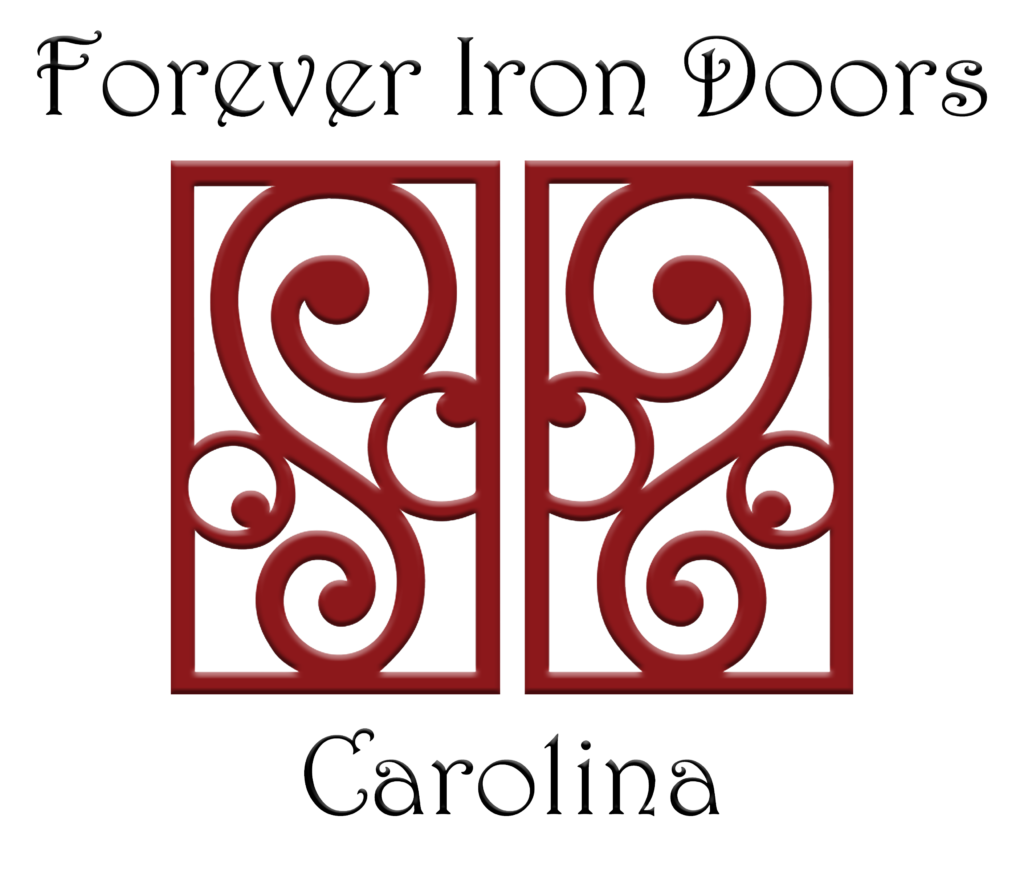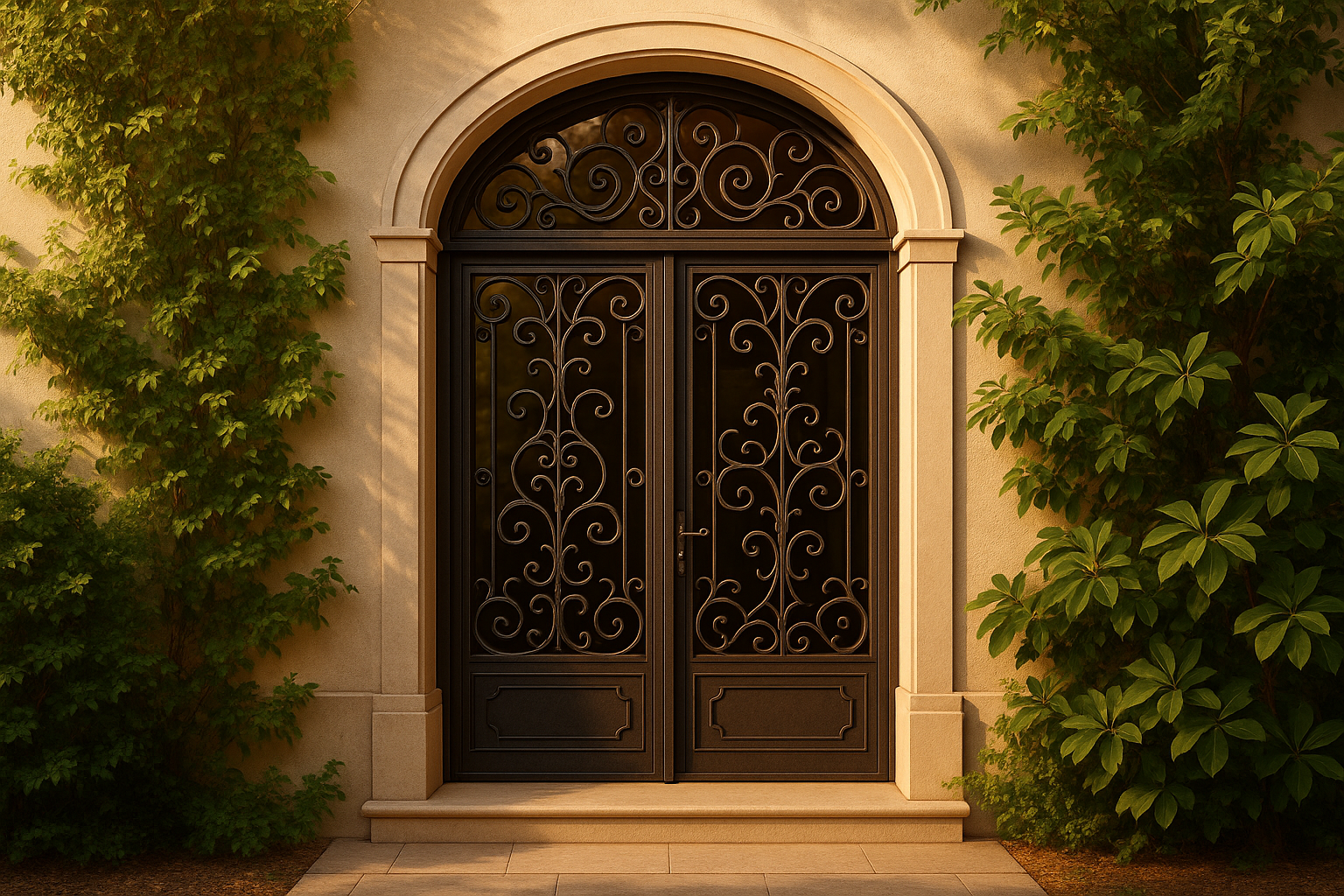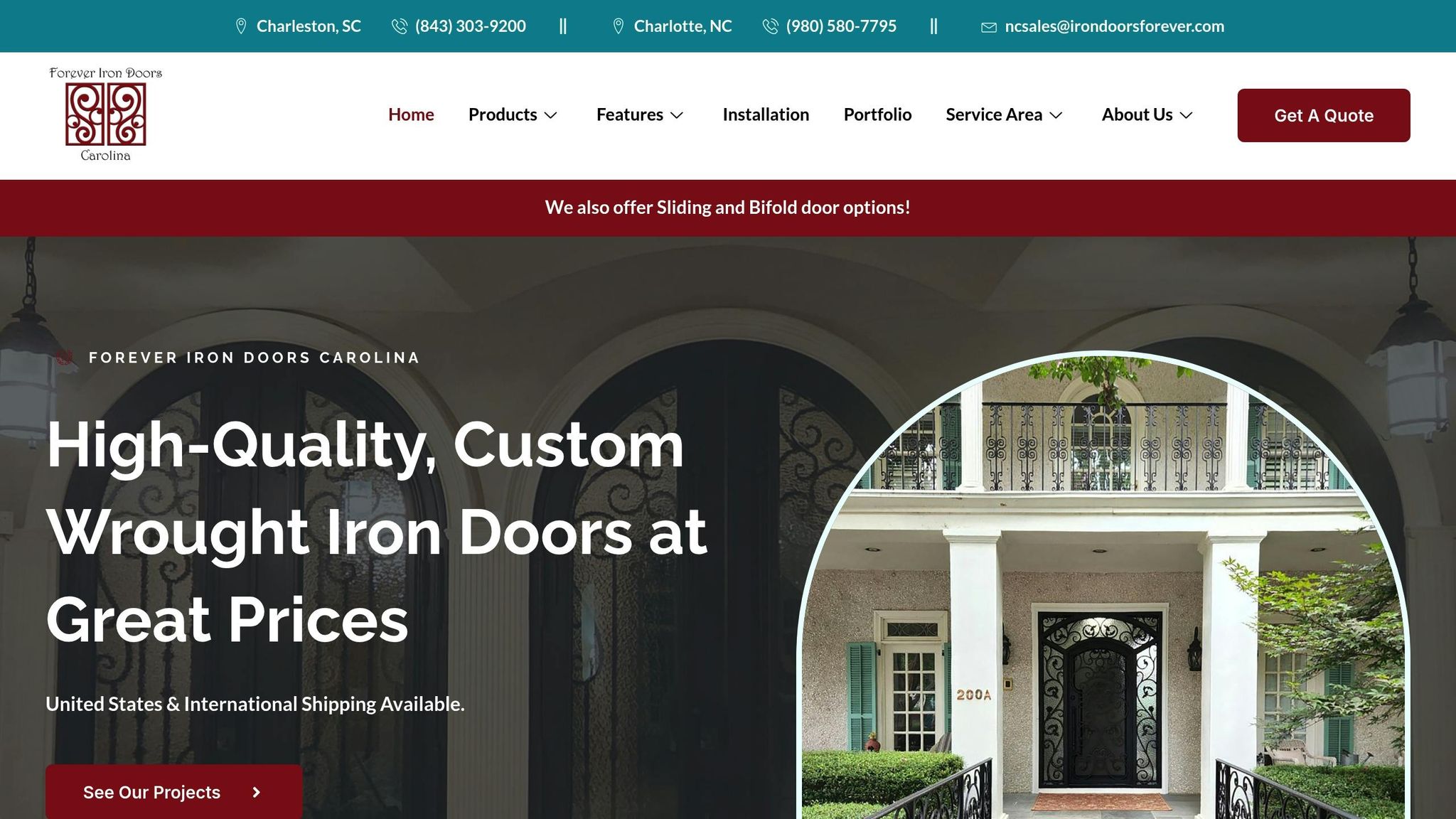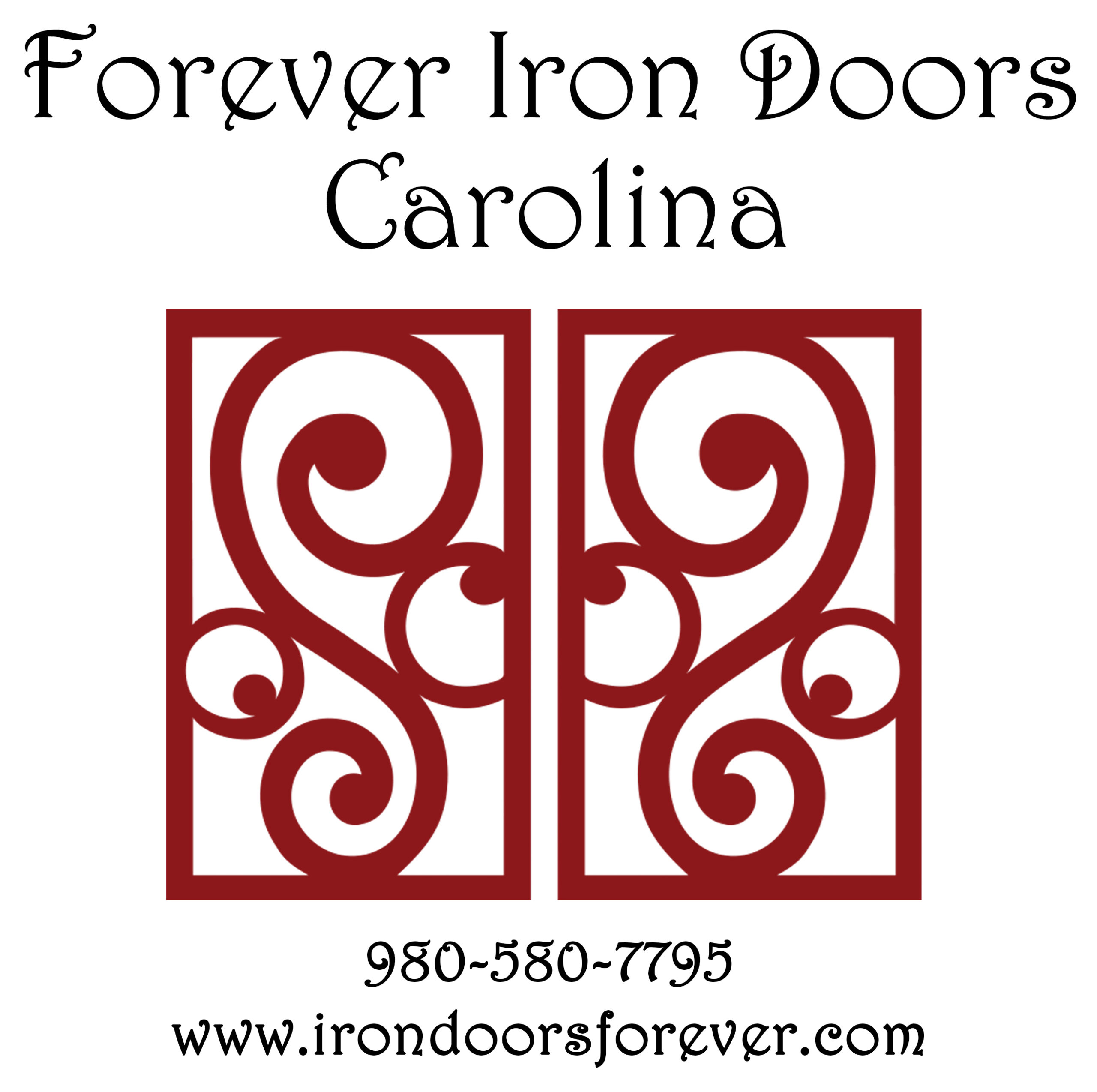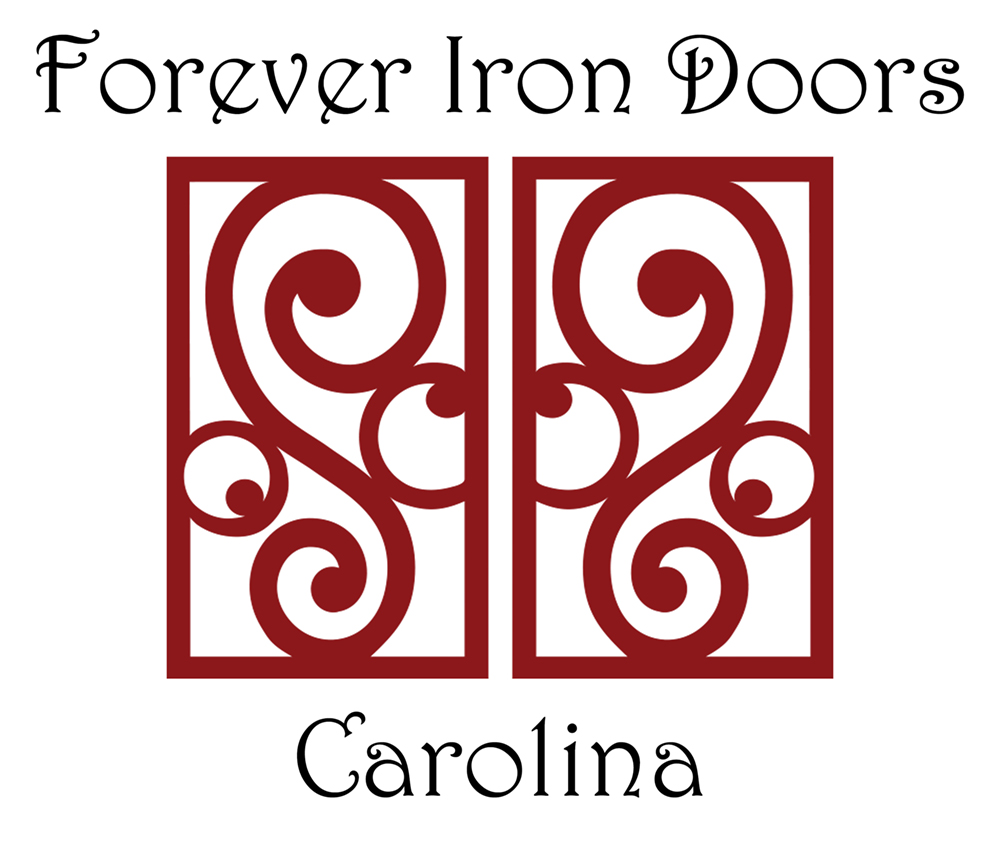A wrought iron entryway adds elegance and security to your home, but keeping it in great shape requires regular upkeep. Neglecting maintenance can lead to rust, corrosion, and costly repairs. Here’s what you need to know:
- Clean monthly: Use mild dish soap, soft brushes, and microfiber cloths. Avoid harsh chemicals and abrasive tools.
- Inspect for rust: Look for peeling paint, discoloration, or moisture buildup, especially in joints and seams.
- Protect finishes: Apply rust-inhibiting primer and exterior metal paint for touch-ups. Use wax or clear sealant every 6–12 months.
- Tailor care to your climate: Coastal, humid, or cold regions may require extra attention, like rinsing off salt or avoiding rock salt near the metal.
- Repair promptly: Fix chips, dents, and loose parts early. For structural or widespread damage, call a professional.
- Prevent weather damage: Install overhangs, replace weather stripping, and inspect after storms to minimize exposure to elements.
Routine care not only preserves your entryway’s appearance but also extends its lifespan. A little effort goes a long way in maintaining both beauty and function.
Cleaning Supplies and Tools You Need
Choosing the right cleaning supplies is key to maintaining protective finishes and preventing corrosion. Here’s a breakdown of the essential materials for safe and effective cleaning.
Best Cleaning Materials
- Mild dish soap: Perfect for regular cleaning when mixed with warm water. It’s gentle enough to avoid stripping protective coatings. Steer clear of antibacterial soaps or products with bleach, as they can damage the finish.
- Soft-bristle brushes: Ideal for reaching detailed scrollwork and intricate designs. Natural or synthetic bristles work well to avoid scratching. Even an old toothbrush can be a handy tool for smaller, hard-to-reach areas.
- Microfiber cloths: These are excellent for cleaning and drying without leaving scratches. Use one set for cleaning and another for polishing to achieve a flawless finish.
- Clean water: Essential for rinsing off any soap residue. Avoid letting tap water air-dry on surfaces, as the minerals and chemicals in it can leave behind unsightly stains.
Why Non-Abrasive Tools Matter
Non-abrasive tools are crucial for preserving the protective coatings on your wrought iron entryway. Abrasive materials can scratch the surface, exposing the metal and compromising its protection.
- Avoid these tools: Squeegees, razor blades, coarse wire brushes, sandpaper, and steel wool. These can scratch and damage the finish. Also, avoid scrubbing too hard, as excessive force can harm the iron and make it more prone to corrosion.
- Steer clear of harsh chemicals: Alkaline, ammoniated, or solvent-based cleaners like benzene, gasoline, acetone, or carbon tetrachloride can strip protective coatings and cause permanent damage.
- Pay attention to temperature: Clean during mild weather conditions. Heat can speed up drying, leaving residues behind.
Regular Cleaning and Dust Removal
Keeping your wrought iron entryway clean is more than just about looks – it’s about protecting it from long-term damage. Dirt and debris can trap moisture, which eventually leads to corrosion. To prevent this, clean your entryway monthly under normal conditions. During pollen-heavy seasons or after storms, consider cleaning every two weeks. In harsher climates, aim for at least once per season to stay ahead of potential damage.
Step-by-Step Cleaning Process
Here’s how to clean your wrought iron entryway effectively while preserving its finish:
Start by removing loose debris before applying any cleaning solution. This step is key to avoiding scratches. Use a soft-bristled brush or compressed air to clear dirt from crevices and decorative details.
Next, mix your cleaning solution. Combine a few drops of mild dish soap with warm water – just enough to create a light lather. Avoid overdoing the soap, as excessive suds can leave behind residue that attracts dirt.
When washing, work from top to bottom. This method ensures dirty water doesn’t drip onto already-cleaned areas. Use a microfiber cloth or soft brush to gently scrub the surface, focusing on areas prone to buildup, like horizontal sections and intricate designs.
After scrubbing, rinse thoroughly with clean water to remove all soap. Leftover residue can attract dirt and speed up corrosion. Once rinsed, immediately dry the surface with a microfiber cloth. Letting water air-dry can leave mineral spots and create conditions for rust.
How to Clean Hard-to-Reach Areas
Intricate designs and tight spaces require extra attention. These areas often trap moisture, making them more vulnerable to rust. Use tools like compressed air or an old toothbrush to clean detailed crevices and decorative scrollwork.
When working on ornate patterns, gently brush into each crevice to clear debris. Take your time to ensure moisture doesn’t linger, as even small amounts can lead to rust over time.
Drying is especially important for these hard-to-reach spots. After cleaning, use compressed air or a small, dry brush to remove moisture from crevices. Pay close attention to joints where iron pieces connect, as these areas are prone to collecting debris and holding moisture longer than flat surfaces. A thorough, systematic approach to cleaning and drying these details will help maintain your entryway’s beauty and durability.
Rust Prevention and Early Treatment
Regular cleaning not only keeps your ironwork looking great but also helps you spot subtle signs of rust before they become a bigger issue. After each cleaning session, take a moment to check for any early signs of wear or corrosion. Rust often starts small, but catching it early can save you from dealing with more serious damage down the road. Let’s dive into how to identify these early warning signs during your routine inspections.
How to Spot Rust Early
When conducting monthly inspections, look for peeling or flaking paint. These can expose the underlying metal, making it vulnerable to moisture and air – prime conditions for rust to form.
Pay attention to surface discoloration, too. Wrought iron often develops a patina, a thin layer of discoloration that can act as a natural shield against rust. But if moisture lingers for too long, even this protective layer can break down, leading to rust.
Don’t forget to check areas where moisture tends to collect, like joints or seams. Use a flashlight to carefully examine hard-to-reach spots for any early signs of rust that might otherwise go unnoticed.
Touch-Ups, Repairs, and When to Call Professionals
Even with regular care, your wrought iron entryway might need occasional touch-ups or repairs. Knowing when to tackle these fixes yourself and when to bring in a professional can save you both time and money. Here’s a guide to help you decide.
Fixing Paint and Finishes
Small chips, scratches, and worn spots are common and easy to fix. Start by cleaning the damaged area with a wire brush or fine-grit sandpaper, then let it dry completely.
Next, apply a rust-inhibiting primer made for metal surfaces. This primer not only protects the metal but also ensures the new paint adheres properly. Once the primer has fully cured, apply a topcoat of exterior metal paint that matches your existing finish. Use thin, even layers rather than a single thick coat to prevent drips and achieve smooth coverage.
If your entryway has a powder-coated finish, the process is slightly different. Clean the affected area with denatured alcohol, lightly sand with 400-grit sandpaper, and use a matching powder coating touch-up product to blend seamlessly with the existing surface.
For best results, avoid painting when the temperature is below 50°F or above 85°F, or in conditions of high humidity or direct sunlight, as these can affect how the paint cures.
Fixing Minor Surface Damage
For small dents or surface imperfections, automotive filler or metal epoxy putty works well. Begin by cleaning the area down to the bare metal, removing any paint, rust, or debris. Mix the filler according to the instructions, apply it slightly above the surrounding surface, and sand it smooth once it hardens. Start with 120-grit sandpaper and finish with 320-grit for a polished result.
If decorative elements like scrollwork or other details are loose, check if they can be re-welded or reattached with a high-strength metal adhesive. Metal bonding epoxy is a great option for securing small pieces, as long as the surfaces are clean and held in place until the adhesive sets.
For squeaky hinges, a quick fix can make a big difference. Remove the hinge pins, clean them with steel wool to remove rust or debris, and apply a thin layer of white lithium grease before reassembling. Avoid using penetrating oils like WD-40, as they can attract dirt and create more problems down the line.
When to Call a Professional
While many repairs are manageable on your own, some situations require professional expertise. Structural issues, such as sagging, warping, or cracks in the door frame or main elements, should be addressed by a professional to ensure safety and durability.
If rust damage is widespread, it’s best to consult experts who have access to advanced tools and industrial-grade primers for long-lasting protection. Similarly, complex hardware issues – like a door that won’t close properly, a malfunctioning lock, or severely worn hinges – are better left to professionals.
For doors with integrated electrical features, such as lighting, security systems, or automated opening mechanisms, always turn to qualified professionals to avoid safety risks.
If you’re looking to restore or upgrade the finish on your entryway, consider reaching out to Forever Iron Doors Carolina. They specialize in expert color matching for large areas and offer faux painting and finish services to refresh your entryway. Professional refinishing not only delivers a polished, like-new appearance but also tends to last longer than DIY efforts, often coming with warranty protection for added peace of mind.
sbb-itb-cd90297
Weather-Based Maintenance Tips
Keeping your wrought iron entryway in top shape means adapting your maintenance routine to the local weather. Different climates pose unique challenges: coastal salt air speeds up rust, desert heat and UV rays wear down finishes, and northern freeze-thaw cycles can loosen hardware over time.
By understanding your area’s weather patterns, you can schedule maintenance at the right times and catch issues early – saving yourself from expensive repairs down the road.
Adjusting for Your Local Climate
Each climate brings its own set of maintenance needs. Here’s how to tailor your upkeep:
- High-Humidity Areas (e.g., Southeast): Summers can be tough on wrought iron due to rust, especially around joints. Inspect every 4–6 weeks during the warmer months and apply protective wax quarterly to keep corrosion at bay.
- Coastal Properties: Salt spray is a major culprit here. Rinse your entryway with fresh water weekly, especially after storms, to remove salt deposits. Since salt can break down protective coatings faster, plan for annual paint touch-ups instead of the usual 2–3 years.
- Cold Climates: Ice and snow can wreak havoc on iron. Avoid using rock salt or calcium chloride near your entryway, as they speed up rusting. Instead, use sand or kitty litter for traction. After storms, brush off snow and check for ice buildup that could damage the metal.
- Desert Environments: The intense sun and temperature swings in deserts can cause coatings to crack and hardware to loosen. Inspect during cool morning hours when the metal has contracted. Apply a UV-resistant topcoat every 18 months to protect against fading and cracking.
- Rainy Regions (e.g., Pacific Northwest): Heavy rain demands good drainage. Make sure gutters and downspouts direct water away from your entryway, and check that the ground slopes away from the foundation. Clean door frame drainage channels monthly during the wet season to prevent water from pooling.
By adjusting your inspection schedule and maintenance steps to your local climate, you’ll significantly extend the life of your entryway.
Weather Protection Methods
To further protect your entryway, consider these proactive strategies:
- Overhead Protection: Installing a small overhang or awning can shield your door from direct rain and UV rays. Even a 2-foot overhang can reduce the wear and tear on your entryway, cutting down on maintenance needs.
- Door Sweeps and Weather Stripping: These additions not only improve energy efficiency but also stop water from pooling in the door frame, where rust can form. Replace weather stripping annually and choose materials suited to your climate. EPDM rubber works well in most conditions, while silicone strips handle extreme temperatures better.
- Seasonal Maintenance: Adjust your routine based on the season. Before winter, apply a thin coat of car wax to exposed metal for added moisture resistance. In spring, power wash away any salt or grime left from winter and inspect for damage as you plan your yearly touch-ups.
- Landscaping Considerations: Avoid planting gardens that require frequent watering near your iron door, as constant moisture can encourage rust. Instead, choose drought-resistant plants or use decorative gravel to keep water away from metal surfaces.
- Severe Weather Inspections: If you live in a tornado or hurricane-prone area, check your entryway after major storms. High winds can cause debris to chip the finish, exposing bare metal to moisture. Address any damage within a week to stop rust from forming.
Working with Forever Iron Doors Carolina
Routine maintenance goes a long way, but teaming up with experts can ensure your iron entryway remains both stunning and durable for years to come.
Forever Iron Doors Carolina specializes in custom design, professional installation, and ongoing support. They provide tailored solutions that not only enhance your home’s aesthetic but also address the challenges posed by the local climate, helping to reduce future upkeep.
Custom Design and Professional Installation
Forever Iron Doors Carolina offers a variety of customization options that make maintaining your entryway simpler while ensuring it aligns beautifully with your home’s design. Their selection of glass styles includes decorative and insulated options, which improve energy efficiency and help manage moisture.
When it comes to finishes, they provide powder-coated options in classic matte black, rich bronze, charcoal, and other custom colors, with finish codes ranging from CS-001 through CS-20. These finishes are applied in the factory and are known for their durability.
A proper installation is key to long-term performance. Their team of certified installers and master carpenters ensures your door is not only visually appealing but also structurally sound.
"We want to make sure your home’s framing is structurally sound and your new iron door is level and operating smoothly. We’ll also make sure that the molding and caulk is applied professionally and in proper working order."
- Forever Custom Iron Doors
Meticulous sealing prevents water infiltration and related issues, while hardware options – available in satin nickel, oil-rubbed bronze, and matte black – are chosen for their durability in varying weather conditions.
Forever Iron Doors Carolina stands behind their work with a lifetime guarantee:
"All of our work is guaranteed for the life of your door to provide many years of beauty, style, and added security."
- Forever Custom Iron Doors
With expert installation as the foundation, their additional finish services further protect and enhance your entryway.
Faux Painting and Finish Services
To elevate the appearance and longevity of your entryway, Forever Iron Doors Carolina offers specialized faux painting services. Their master faux painters can either match existing colors or create custom designs that perfectly align with your home’s architecture.
These finishes – available in aged bronze, rust patina, and antique copper – are applied using a multi-coat process designed to resist wear and environmental damage. This layered approach is particularly beneficial for homes in coastal or humid regions.
"Our thorough surface preparation and specialized paint selection ensure that each finished product resists chips, fading, and regular wear, adding longevity to your investment."
- Forever Custom Iron Doors
Their faux painting services extend beyond doors to include railings, interior and exterior windows, and other ironwork. This allows homeowners to maintain a cohesive look across their property. For those in challenging climates, scheduling these finish services as part of regular maintenance can keep your ironwork looking as fresh as the day it was installed.
Conclusion: Keeping Your Iron Entryway Looking Great
Your wrought iron entryway is more than just a door – it’s an investment that combines elegance with security. To protect that investment, regular maintenance is essential. From cleaning and inspections to touch-ups, every small effort plays a big role in preserving both its beauty and functionality.
Monthly inspections are a smart habit to adopt. During these quick checkups, look for rust starting to form, chips or wear in the protective finish, and any issues with the hardware. Catching these problems early can save you from expensive repairs down the road.
When it comes to cleaning, consider your local climate. A mild soap-based cleaner works well, but always make sure to dry the surface thoroughly to avoid moisture buildup.
Protective coatings are your iron entryway’s best friend. Applying a high-quality wax or clear sealant every 6–12 months creates a barrier against moisture and extends the life of your door. If you notice the finish wearing down, don’t wait – touch it up with a durable exterior metal paint to keep rust at bay.
Don’t overlook the hardware. Regularly lubricating hinges and locks, along with checking their alignment, ensures everything operates smoothly. A little attention here goes a long way in avoiding the hassle of a sticky or improperly closing door.
FAQs
How often should I check my wrought iron entryway for rust, and which parts are most at risk?
To keep your wrought iron entryway in top shape, make it a habit to inspect it every 6 to 12 months. Focus closely on joints, corners, and any spots with scratches or chipped paint, as these areas are especially vulnerable to moisture and rust. Routine checks like these go a long way in preserving the look and strength of your entryway over time.
How can I maintain my wrought iron entryway in a humid or coastal environment?
Keeping your wrought iron entryway in great shape, especially in humid or coastal areas, requires consistent care. Start by washing the surface with a mild, non-abrasive soap and water. This helps remove salt, dirt, and moisture that can cause rust or corrosion. Once cleaned, make sure to dry the surface completely to avoid trapping moisture.
To protect against the elements, apply a marine-grade protective coating or a rust-inhibitive sealant. These create a shield against humidity and salty air. Regularly inspect your entryway for any signs of rust or damage. If you spot trouble areas, sand them down and repaint as needed. Also, check that water drains properly around the entryway to prevent pooling, which can speed up wear and tear. By following these steps, your wrought iron entryway can remain sturdy and stylish for years.
When should I call a professional to repair my wrought iron entryway, and what problems require expert attention?
If your wrought iron entryway shows signs of extensive rust, cracks, or structural damage, it’s time to call in a professional. These kinds of issues usually require specialized tools and expertise, like welding, to restore the entryway’s safety, durability, and appearance.
Additionally, professional assistance is crucial if the door becomes misaligned, if hinges or locks start to wear out, or if the damage affects its functionality or security. Tackling these problems quickly can help preserve both the elegance and lifespan of your entryway.
